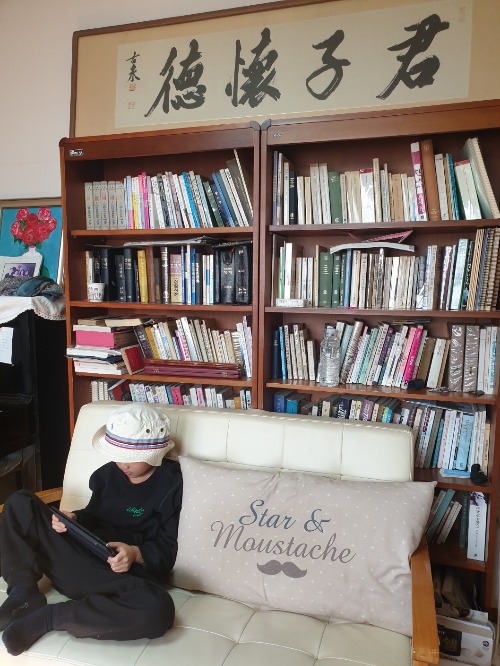데일리스터디
The Pasture / Robert Frost 본문
I'm going out to clean the pasture spring;
I'll only stop to rake the leaves away
(And wait to watch the water clear, I may):
I sha'n't be gone long.—You come too.
I'm going out to fetch the little calf
That's standing by the mother. It's so young,
It totters when she licks it with her tongue.
I sha'n't be gone long.—You come too.

Study Guide: Robert Frost's "The Pasture"
Quiz
- What is the speaker's initial task mentioned in the poem?
- What specific action does the speaker say they might do while cleaning the spring?
- How long does the speaker anticipate being gone for the first task?
- What is the second task the speaker plans to undertake?
- What characteristic is mentioned about the young calf?
- How does the mother cow interact with the calf, according to the poem?
- What is the repeated phrase in the poem, and what does it suggest?
- What kind of atmosphere is depicted in the accompanying image description?
- What two specific elements are shown in the foreground and background of the image description?
- What tool is the person in the image described as using?
Answer Key
- The speaker's initial task is to clean the pasture spring. This involves removing leaves from the spring to clear it.
- While cleaning the spring, the speaker says they might "wait to watch the water clear." This suggests a patient appreciation for the natural process.
- For the first task of cleaning the spring, the speaker explicitly states, "I sha'n't be gone long." This implies the task is not lengthy or arduous.
- The second task the speaker plans is to fetch the little calf that is standing by its mother. This suggests bringing the calf closer or tending to it.
- The young calf is described as being "so young, / It totters when she licks it with her tongue." This highlights its newness and instability.
- The mother cow interacts with the calf by licking it with her tongue, which causes the calf to totter due to its youth. This shows a tender, natural interaction.
- The repeated phrase in the poem is "I sha'n't be gone long.—You come too." This repeated invitation suggests a desire for companionship and sharing simple moments in nature.
- The accompanying image description depicts an atmosphere that is "peaceful and intimate," highlighting a quiet invitation to share in natural life.
- In the foreground of the image, a person is shown raking leaves from a clear spring. In the gentle background, a young calf is standing close to its mother.
- The person in the image is described as using a rake to clear leaves away from the spring.
Essay Format Questions
- Analyze how Robert Frost uses simple language and a repetitive structure in "The Pasture" to convey a profound sense of invitation and connection to nature.
- Discuss the significance of the two distinct tasks the speaker undertakes in the poem (cleaning the spring and fetching the calf). What do these actions reveal about the speaker's relationship with the natural world and their values?
- Explore the theme of companionship as presented in "The Pasture." How does the repeated invitation "You come too" function within the poem, and what does it suggest about the human desire for shared experiences?
- Consider the imagery created by the poem and the accompanying image description. How do these elements collectively contribute to the overall mood and message of "The Pasture"?
- "The Pasture" is often seen as a gentle invitation. Discuss how the poem's tone and subject matter evoke a sense of tranquility and an appreciation for the simple moments in life.
Glossary of Key Terms
- Pasture: A piece of land covered with grass and other low plants suitable for grazing animals, especially cattle or sheep.
- Spring: A natural outflow of ground water. In the poem, it refers to a small source of water in the pasture.
- Rake: A tool with a long handle and a row of teeth at the head, used for gathering leaves or smoothing soil.
- Calf: A young bovine animal, especially a young cow or bull.
- Totters: Walks with unsteady steps; sways unsteadily.
- "I sha'n't be gone long": A contraction of "I shall not be gone long," meaning the speaker will return quickly or the task will not take much time.
- "You come too": A direct invitation from the speaker to another person to join them.
- Sun-dappled: Describing an area where sunlight filters through leaves or other objects, creating shifting patterns of light and shadow.
- Overgrown: Covered with an excessive growth of plants.
- Intimate: Closely acquainted; familiar, private, or personal. In this context, suggesting a deep, personal connection to the natural setting.
( N.B. 위 콘텐츠는 Google AI Studio 로 제작한 것입니다 )
'동시' 카테고리의 다른 글
| Jabberwocky / Lewis Carroll (0) | 2025.05.16 |
|---|---|
| Trees / Joyce Kilmer (0) | 2025.05.16 |
| Daffodils / William Wordsworth (0) | 2025.05.16 |
| At the Zoo / William Makepeace Thackeray (0) | 2025.05.16 |
| The Rainbow / Christina Rossetti (0) | 2025.05.16 |





